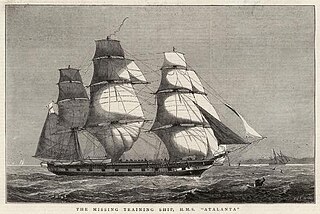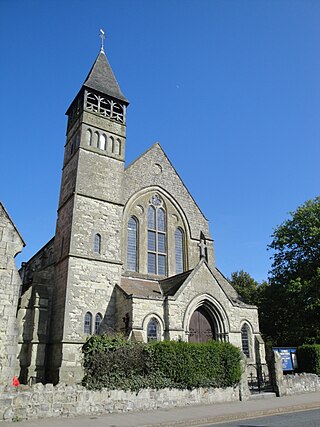
Sandown is a seaside resort town and civil parish on the south-east coast of the Isle of Wight, England. The resort of Shanklin and the settlement of Lake are sited just to the south of the town. Sandown has a population of 11,654, according to the 2021 Census; together with Shanklin and Lake, it forms a built-up area of around 25,000 inhabitants. It is the northernmost town of Sandown Bay, with an easily accessible, sandy shoreline with beaches that run continuously from the cliffs at Battery Gardens in the south to Yaverland in the north.

Shanklin is a seaside resort town and civil parish on the Isle of Wight, England, located on Sandown Bay. Shanklin is the southernmost of three settlements which occupy the bay, and is close to Lake Sandown. The sandy beach, its Old Village and a wooded ravine, Shanklin Chine, are its main attractions. The esplanade along the beach is occupied by hotels and restaurants for the most part, and is one of the most tourist-oriented parts of the town. The other is the Old Village, at the top of Shanklin Chine. Together with Lake and Sandown to the north, Shanklin forms a built up area of around 25,000 inhabitants, Shanklin alone contributing around 7,200 of this.
HMS Thunderer was a ship of the line of the Royal Navy, built in 1783. She carried 74-guns, being classified as a third rate. During her service she took part in several prominent naval battles of the French Revolutionary Wars and the Napoleonic Wars; including the Glorious First of June, the Battle of Cape Finisterre and the Battle of Trafalgar.

HMS Challenger was a Pearl-class corvette of the Royal Navy launched on 13 February 1858 at the Woolwich Dockyard. She served the flagship of the Australia Station between 1866 and 1870.

PNS Rah Naward is a sail training ship of the Pakistan Navy. She was commissioned in 2001 as Prince William for the Tall Ships Youth Trust and sold in 2010 to the Pakistan Navy and renamed Rah Naward.

HMSJuno was a 26-gun Spartan-class sixth-rate frigate of the Royal Navy launched in 1844 at Pembroke. As HMS Juno, she carried out the historic role in 1857 of annexing the Cocos (Keeling) Islands to the British Empire. She was renamed HMS Mariner in January 1878 and then HMS Atalanta two weeks later.

HMS Pique was a wooden fifth-rate sailing frigate of the Royal Navy, designed by Sir William Symonds. She was launched on 21 July 1834 at Devonport. The vessel was of 1,633 tons burthen and had 36 guns. She was broken up in 1910.

HMS Dauntless was a Danae-class light cruiser of the Royal Navy. She was built by Palmers Shipbuilding and Iron Company of Jarrow, launched on 10 April 1918 and commissioned on 22 November 1918.

HMS Fisgard was a 46-gun fifth rate Leda-class frigate of the Royal Navy. She spent sixty years in service on a variety of duties.

St. Paul's Church, Gatten, Shanklin is a parish church in the Church of England located in Shanklin, Isle of Wight.
HMS Eurydice was a 24-gun Porcupine-class post ship of the Royal Navy built in 1781 and broken up in 1834. During her long career she saw service in the American War of Independence, the French Revolutionary Wars and the Napoleonic Wars. She captured a number of enemy privateers and served in the East and West Indies, the Mediterranean and British and American waters.

Admiral Sir George Elliot was a Royal Navy officer who served during the French Revolutionary and Napoleonic Wars, and the First Opium War.

HMS Arab was a 22-gun post ship of the Royal Navy. She was formerly the 18-gun French privateer Brave, which the British captured in 1798. She served during the French Revolutionary and Napoleonic Wars until she was sold in 1810.

HMS Comus was a corvette of the Royal Navy. She was the name ship of her class. Launched in April 1878, the vessel was built by Messrs. J. Elder & Co of Glasgow at a cost of £123,000.

HMS Basilisk was a first-class paddle sloop of the Royal Navy, built at the Woolwich Dockyard and launched on 22 August 1848.

HMS Pelican was an 18-gun Cruizer-class brig-sloop of the Royal Navy, launched in August 1812. She is perhaps best known for her capture in August 1813 of the brig USS Argus. When the navy sold Pelican in 1865 she was the last Cruizer-class vessel still in service.

Dunnose is a cape on the Isle of Wight in the English Channel. The headland is visible from well out to sea, and is used in navigation. It has twice been used as the base point for a triangulation of Great Britain. The line of accurately surveyed points running north from Dunnose to Clifton in Yorkshire provide the basis for triangulation to determine the positions of all other locations in Britain.

HMS Scylla was an 18-gun Cruizer-class brig-sloop of the Royal Navy. The first to bear the name Scylla, she was launched in 1809 and broken up in 1846.

HMS Encounter was ordered as a First-Class Sloop with screw propulsion on 5 February 1845 to be built at Pembroke, in accordance with the design developed by John Fincham, Master Shipwright at Portsmouth. Her armament was to consist of 8 guns. She was to have a more powerful steam engine rated at 360 nominal horsepower. In 1848 she would be altered abaft and lengthened at Deptford prior to completion. A second vessel (Harrier) was ordered on 26 March 1846 but after her keel was laid at Pembroke Dockyard, her construction was suspended on 9 September 1846 then cancelled five years later, on 4 April 1851. Encounter had her armament radically altered in 1850 and she was broken up at Devonport in 1866.

HMS Vestal was a 26-gun Vestal-class sixth-rate frigate of the Royal Navy. She was built to a design by Sir William Symonds and was launched in 1833.





















